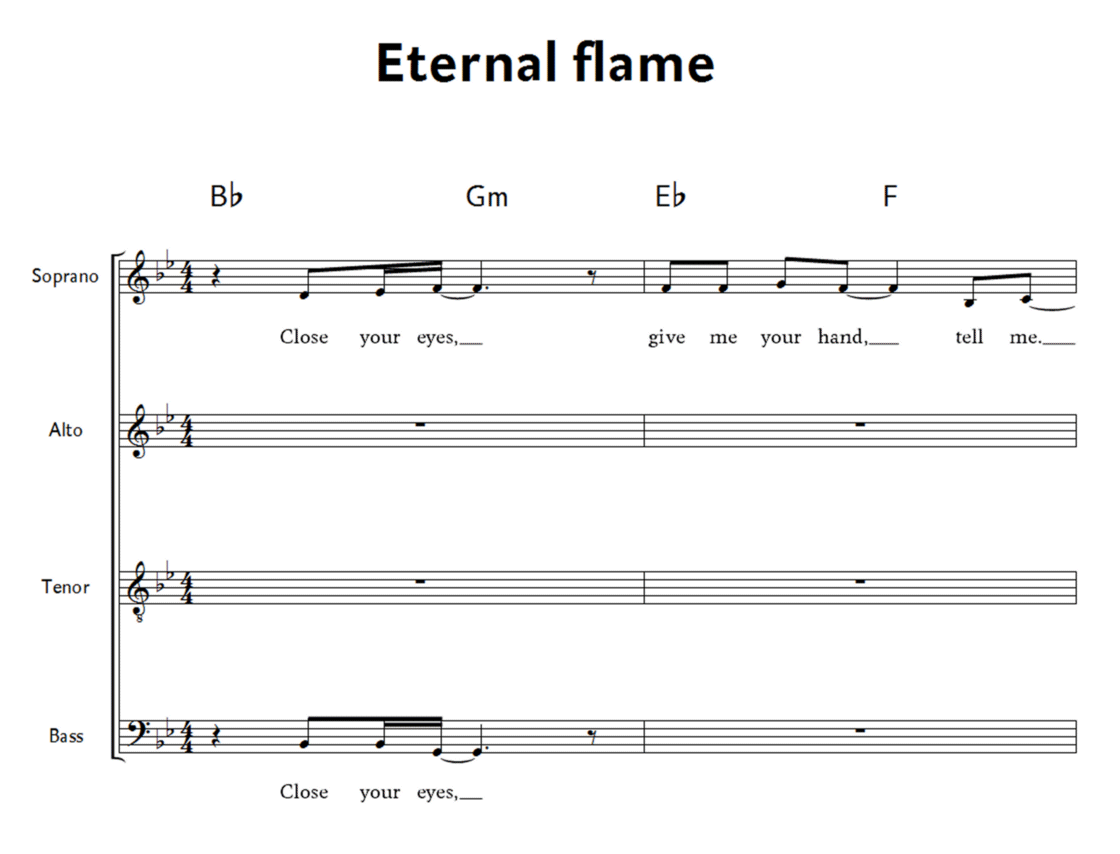 One of the basic techniques of arranging is writing homophonic parts. Homophonic means that all voice groups sing the same lyrics at the same time. In this exercise you will be writing simple four-part chords in the song Eternal flame by The Bangles. In the accompanying pdf the melody and chord symbols are given. As an example, the first bar of the bass is written out. The exercise looks like this:
One of the basic techniques of arranging is writing homophonic parts. Homophonic means that all voice groups sing the same lyrics at the same time. In this exercise you will be writing simple four-part chords in the song Eternal flame by The Bangles. In the accompanying pdf the melody and chord symbols are given. As an example, the first bar of the bass is written out. The exercise looks like this:

Here is the exercise as a pdf file. The idea is to write the alto, tenor and bass, and keeping the chords strictly homophonic and without division. In this working-out, the three upper voices make narrow harmonies as much as possible, because that kind of voicings sound well in pop music. Furthermore, I have tried to let the harmonies fit the lyrical character of the piece:
Here is an explanation of some choices made in the working-out:
- Bar 1: the bass is moving down to G, in counter movement to the melody. This technique creates a sophisticated sound.
- Bar 2: in the chord
E@
, apart from the ninth that is in the melody, the major seventh fits well. But because there are only four voices, the harmony cannot contain the fifth (the note B-flat) and the major seventh (the note D). That’s why the alto is singing B-flat at first and is subsequently jumping to D. - Bar 2: the notes on “tell me” are rather low for the soprano. This is solved by letting the altos sing with the sopranos. The tenor moves in parallel with the female voices a third down.
- Bar 3: this time the bass is going up to the G, creating some variety in the part and letting the voice group sing some high notes.
- Bar 3: the melody has a syncopation on “burn-” and the three lower voices have the same syncopation. This means the tenor and bass start the harmony from bar 4 in the last eighth note of bar 3.
- Bar 4: in the harmonies on “-der-stand” a parallel fifth occurs. It doesn’t sound great, but this can hardly be avoided. Fortunately, the notes pass quickly.
- Bar 6: the tenor is moving in thirds (or rather: in sixths) with the melody. Such a parallel creates a beautiful, flowing character. In the alto however, the same kind of parallel is not written. Because if three voices move in parallel, in many cases the sound gets to be too jazzy. Therefore, in the alto some jumps are written.
- Bar 7: in my view the chord
F
is in need of an extension, to make it sound a little more interesting than a simple triad. But, the voicing with the ninth as well as the voicing with the major seventh both sounded too straightforward to me. That’s why I created a little movement in the tenor, going from the ninth to the major seventh. - Bar 8-9: the bass is starting on a low C and is jumping up an octave. In this way, the voice group gets to sing some high notes as well and the four parts are more balanced in volume.